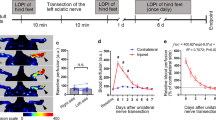Abstract
We studied the interaction between the vasoconstriction evoked by postganglionic sympathetic neurones (sympathetic vasoconstriction) and the vasodilatation mediated by small-diameter afferent neurones (antidromic vasodilatation) in hairless skin of anaesthetized rats kept under controlled conditions. In all animals both the lumbar sympathetic trunk (LST) and the ipsilateral dorsal root (DR) L5 were surgically exposed, sectioned and electrically stimulated using different protocols. This experimental approach results in the exclusive and selective activation of sympathetic efferents and primary afferents respectively. Blood flow responses were measured using laser Doppler flowmetry. Sectioning the LST resulted in a pronounced increase in cutaneous blood flow by 112±15% (mean±SEM, n=25) indicating that ongoing sympathetic vasoconstrictor activity had been abolished. When a brief antidromic vasodilatation was produced by DR stimulation with 10–15 pulses at 1 Hz with C-fibre intensity during a sustained sympathetic vasoconstriction, peak blood flow reached preconstriction levels at LST stimulation frequencies of ≤3 Hz. By contrast, antidromic vasodilatation was reduced at sympathetic stimulation frequencies of ≥5 Hz and absent when stimulating the LST with 20 Hz. A similar response characteristic was obtained when LST and DR stimulation were started simultaneously. Continuous DR stimulation with 0.1 Hz evoked a substantial increase in cutaneous blood flow by 38±10% (mean±SEM, n=8) to a new baseline level. When sympathetic vasoconstriction was elicited on this background DR stimulation, the responses were smaller at all sympathetic frequencies. However, the maximum decrease in blood flow was significantly smaller than the controls at LST stimulation with ≤3 Hz but not at higher frequencies. We conclude that sympathetic vasoconstriction and antidromic vasodilatation are competitive influences in the control of cutaneous blood flow. At low levels of cutaneous sympathetic vasoconstrictor activity, which probably prevail under resting conditions in the absence of cold stress, antidromic vasodilatation overrides sympathetic vasoconstriction. At high levels of cutaneous sympathetic activity, which may be reached in normal life under the conditions of severe cold, sympathetic vasoconstriction can suppress antidromic vasodilatation almost totally.
Similar content being viewed by others
Author information
Authors and Affiliations
Additional information
Received: 24 April 1996 / Accepted: 3 September 1996
Rights and permissions
About this article
Cite this article
Häbler, HJ., Wasner, G. & Jänig, W. Interaction of sympathetic vasoconstriction and antidromic vasodilatation in the control of skin blood flow. Exp Brain Res 113, 402–410 (1997). https://doi.org/10.1007/PL00005594
Issue Date:
DOI: https://doi.org/10.1007/PL00005594




